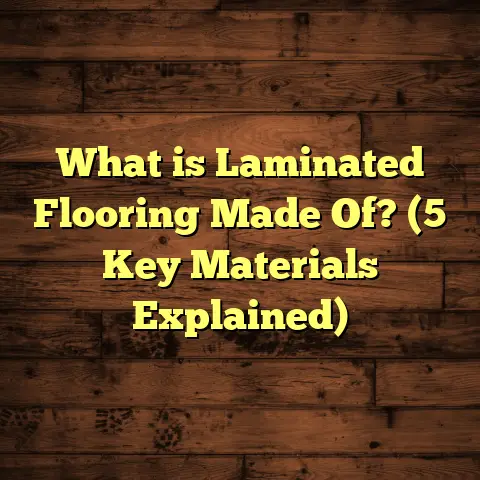What is Wood Flooring Finishing? (5 Essential Techniques Revealed)
I remember the first time I faced the challenge of finishing a wood floor. The wood was beautiful but raw, and I had no idea how to protect it while making it look stunning. Finishing wood flooring isn’t just about slapping on a coat of something shiny; it’s a craft that combines protection, aesthetics, and longevity. If you’ve ever wondered what wood flooring finishing really means or how to choose the right technique, I’m here to walk you through everything I’ve learned over the years.
What is Wood Flooring Finishing?
Wood flooring finishing is the process of applying protective and decorative coatings to wood floors after they have been installed and sanded. This finishing layer enhances the floor’s durability, appearance, and resistance to wear and tear. Essentially, it’s what turns a rough, vulnerable wooden surface into a smooth, attractive, and long-lasting floor.
Finishes can vary widely—from clear coatings that highlight the natural grain of the wood, to tinted stains that change its color entirely. But more than just looks, finishes protect the wood from moisture, scratches, dents, and UV damage.
When I first started working with wood floors, I thought finishing was simply about shine. Over time, I realized finishing is a blend of art and science—choosing the right product depends on the wood type, location of the floor, expected wear, and even your lifestyle.
What Happens if You Don’t Finish Wood Floors?
Leaving wood floors unfinished leaves them vulnerable to damage. Unfinished wood absorbs moisture easily, leading to warping or mold growth in humid environments. Scratches and stains become permanent marks without any protective barrier. In one job I did early in my career, an unfinished pine floor in a kitchen quickly absorbed spilled liquids and showed deep stains within weeks.
Research from the Hardwood Manufacturers Association reveals that finished hardwood floors retain their structural integrity and aesthetic appeal far longer than unfinished counterparts. Proper finishing can extend a floor’s life by decades.
Why Does Wood Flooring Need Finishing?
Wood is a natural material that reacts to its environment. Without finishing, it can absorb moisture causing warping or swelling. It’s also vulnerable to scratches and stains from everyday use.
One home I worked on had unfinished oak floors that were beautiful but quickly got dinged from furniture movement and spilled drinks. After refinishing with a durable polyurethane coat, the floors looked fresh and resisted damage much better.
Statistics from the National Wood Flooring Association show that properly finished hardwood floors can last over 100 years with minimal maintenance. That’s a big difference compared to unfinished or poorly finished floors that often need replacement within 10-20 years.
The Basics: What Wood Flooring Finishes Do
Before jumping into types, it’s helpful to understand what wood finishes actually do:
- Protection: They prevent water penetration which can cause swelling and rot.
- Durability: They shield against scratches, dents, and daily wear.
- Aesthetic Enhancement: Finishes highlight wood grain and color.
- Ease of Maintenance: Finished floors are easier to clean and maintain.
- UV Resistance: Some finishes protect against color fading due to sunlight.
From my experience, these goals guide every choice in finishing methods. For instance, in a sunroom with large windows, UV protection is critical to avoid discoloration.
The 5 Essential Wood Flooring Finishing Techniques
Let me share the five finishing techniques I use most often—each has its own strengths depending on what you need.
1. Oil-Based Finishes
Oil-based finishes are classic and give wood a warm, amber tone that deepens over time. They penetrate the wood fibers rather than sitting on top, which keeps the surface feeling natural and soft.
I used this finish on maple floors in a family room where everyone loves barefoot walking. The oil finish gave a subtle sheen without feeling slippery.
- Pros: Deep penetration, rich color enhancement, easy to repair small scratches.
- Cons: Long drying time (up to 24 hours), strong odor during application.
- Durability: Moderate; requires reapplication every 3-5 years for high traffic areas.
How Oil-Based Finishes Work
Oil-based finishes typically contain natural oils like tung or linseed oil or synthetic versions dissolved in solvents like mineral spirits. These oils soak into the wood pores sealing them from inside. The surface remains breathable but is less likely to absorb water or dirt.
When applying oil finish, multiple coats are needed with drying time in between—this layering builds depth while allowing wood to “breathe.” Because it soaks in rather than forming a film on top, scratches are easier to blend by reapplying oil locally.
Historical Context
Traditional oil finishes have been used for centuries in woodworking. Linseed oil was popular among craftsmen in Europe since medieval times because it brought out grain beauty without plastic look of varnish.
2. Water-Based Finishes
Water-based finishes are more modern and popular because they dry quickly and have low odor. Their clear finish doesn’t yellow with age, which is great if you want to keep a light or natural wood color.
I recommended this for a client with white oak floors who wanted a clean, bright look without changing the wood’s shade.
- Pros: Fast drying (2-4 hours), low VOCs (better for indoor air quality), clear finish.
- Cons: Slightly less durable than oil-based; may raise grain requiring extra sanding.
- Durability: High; lasts 5-7 years depending on use.
Science Behind Water-Based Finishes
Water-based finishes use acrylic or urethane polymers suspended in water rather than solvents. When applied, water evaporates quickly leaving behind a thin protective film that is tough yet flexible.
Because they don’t yellow over time like oil-based finishes do, they’re preferred for modern or light-colored woods like ash or maple where maintaining true color is important.
Application Tips
Water-based finishes tend to raise the grain of wood slightly after sanding. I always advise clients to do an initial “grain raising” step by dampening the floor with water before final sanding and finishing. This ensures surface smoothness after finish coats.
3. Wax Finishes
Wax finishes offer a soft luster and smooth feel but provide less protection than other finishes. They’re best for low-traffic areas or antique-style floors where you want an authentic look.
Once, I worked on a historic home restoration where wax was perfect for preserving the original feel of pine floors.
- Pros: Easy to apply and buff by hand; adds warmth to wood.
- Cons: Low durability; needs frequent maintenance (every 6 months).
- Durability: Low; not recommended for kitchens or hallways.
How Wax Protects Wood
Wax doesn’t penetrate deeply but forms a sacrificial layer on top of wood that repels water and dirt while providing a gentle gloss. It’s often made from natural sources like beeswax or carnauba wax combined with oils.
Waxed floors require regular buffing and reapplication because wear removes this protective layer over time. They are less resistant to water spills and scratches than polyurethane or oils.
Best Uses for Wax
In spaces where you want warmth and softness underfoot—like bedrooms or formal living rooms—wax finishes shine. They also work well on reclaimed or antique woods where maintaining original texture is important.
4. Polyurethane Finishes
Polyurethane is one of the toughest finishes available. It forms a hard protective layer over the wood that resists scratches, water, and chemicals. It comes in both oil-based and water-based formulas.
I often use polyurethane in commercial spaces or busy homes because it handles heavy foot traffic exceptionally well.
- Pros: Excellent durability and protection; available in matte to high gloss.
- Cons: Can look plastic-like if over-applied; oil-based versions yellow over time.
- Durability: Very high; up to 10 years or more with proper care.
Polyurethane Chemistry
Polyurethane is a synthetic polymer that cures into a solid film on wood surfaces. Oil-based versions cure slower but form thicker films; water-based ones cure faster with thinner coatings but better clarity.
This finish seals wood completely preventing moisture ingress and providing superior abrasion resistance.
Case Study: Commercial Use
I applied oil-based polyurethane in a busy café with hardwood floors exposed to constant foot traffic and occasional spills. The finish held up well for over 8 years before requiring renewal—proof of its toughness.
5. Hard Wax Oils
Hard wax oils combine penetrating oils with waxes for a finish that protects while keeping a natural feel. They’re gaining popularity because they balance beauty and resilience well.
I’ve applied hard wax oils in kitchens where moisture resistance matters but clients don’t want the plastic look of polyurethane.
- Pros: Natural appearance, water resistant, easy spot repairs.
- Cons: Requires multiple coats; moderate drying time.
- Durability: Moderate to high; lasts around 5 years with maintenance.
How Hard Wax Oils Work
These products soak into the wood like traditional oils but also leave a thin wax layer on top for additional protection against water and dirt. They keep wood breathable yet resilient.
Hard wax oils are often made from blends of natural oils (like sunflower or flaxseed) combined with synthetic waxes for balanced performance.
Personal Experience
A client with children loved how hard wax oil allowed quick fixes of minor scratches without sanding whole floor—a huge time saver compared to polyurethane.
Factors Affecting Wood Floor Finish Longevity
Several variables influence how well your finish will hold up:
- Wood Species: Hardwoods like oak or hickory resist dents better than softwoods like pine.
- Traffic Volume: More foot traffic means faster wear.
- Environmental Conditions: Humidity levels affect wood expansion/contraction impacting finish integrity.
- Maintenance Routine: Proper cleaning extends finish life significantly.
For example, studies show that hardwood floors in climates with stable humidity maintain finish quality longer than those in fluctuating environments like coastal regions.
Preparation Before Finishing: A Step-by-Step Guide
Good finishing starts before applying any product:
- Sanding: Remove old finishes and smooth the surface. Use progressively finer grits for best results.
- Cleaning: Vacuum thoroughly; wipe with tack cloths to remove dust.
- Conditioning (Optional): Some woods benefit from conditioners before staining/finishing.
- Test Patch: Always try finish on small area to check color and adhesion.
- Apply Finish: Follow manufacturer instructions on application method (brush, roller, or pad).
- Drying Time: Allow sufficient curing time between coats.
- Buffing (If Needed): Some finishes require buffing between coats for smoothness.
Over my career, skipping preparation led to uneven finishes or peeling—so I always emphasize this step.
Common Problems with Wood Floor Finishes and How to Fix Them
Even experienced pros face issues sometimes:
- Blistering/Bubbling: Usually caused by moisture trapped under finish; fix by sanding down affected area.
- Peeling/Flaking: Often due to poor surface prep; re-sand entire floor before refinishing.
- Yellowing: Oil-based finishes tend to yellow over time; switch to water-based if clear finish preferred.
- Scratch Marks: Use touch-up kits or spot repair products; deeper damage may require sanding and recoating.
Knowing how products behave helps manage problems effectively—something I learned through trial and error early on.
Trends I’ve Seen in Wood Floor Finishing
Over recent years:
- Water-based finishes have overtaken oil-based in popularity due to environmental regulations and faster drying times.
- Hard wax oils are increasingly favored by homeowners wanting natural looks plus durability.
- DIY finishing kits have improved but still can’t fully replace professional application for best results.
Industry data shows water-based finishes now account for nearly 60% of new hardwood floor coatings sold in North America—a big shift from just 10 years ago when oil-based dominated.
How Much Does Wood Flooring Finishing Cost?
Costs vary depending on:
- Floor size
- Type of finish
- Labor rates in your area
- Floor condition requiring repairs or extra prep
On average:
| Finish Type | Cost per Square Foot (Material + Labor) |
|---|---|
| Oil-Based | $4 – $7 |
| Water-Based | $3 – $6 |
| Wax | $3 – $5 |
| Polyurethane | $4 – $8 |
| Hard Wax Oil | $5 – $9 |
In one project covering 1,000 sq ft with water-based polyurethane, total cost was around $5,000 including prep work—a worthwhile investment considering the lasting protection gained.
What About Environmental Impact?
Finishing products contain chemicals affecting indoor air quality during application and disposal concerns afterward.
Water-based finishes emit fewer volatile organic compounds (VOCs), making them better choices for healthy homes—especially important if anyone has allergies or asthma.
I always advise clients about ventilation during finishing jobs regardless of product used—it makes all the difference in comfort during application days.
Can You Refinish Wood Floors Yourself?
Many homeowners ask if they can do this themselves. My advice:
- Prep work like sanding requires skill and proper equipment—renting a drum sander is common but tricky for beginners.
- Applying finish evenly without bubbles or streaks needs practice.
- Mistakes can be costly if you have to redo entire floor.
If you’re handy and patient, smaller areas or spot repairs are doable DIY projects. For whole floors especially large spaces or valuable hardwoods, hiring pros is usually safer and more cost-effective long term.
My Most Memorable Wood Floor Finishing Project
One project stands out—a century-old farmhouse with gorgeous wide plank cherry floors badly worn down by decades of use. The owners wanted original character preserved but also needed modern durability.
We chose hard wax oil finish applied carefully by hand over several days with multiple coats and buffing sessions between layers.
The result? Floors looked revitalized yet natural—soft sheen highlighting grain patterns without plastic shine. The family was thrilled how well it resisted everyday messes while keeping historic charm intact.
This project taught me that sometimes mixing traditional methods with modern products achieves best results—there’s no one-size-fits-all approach here.
FAQs About Wood Flooring Finishing
Q: How often should I refinish my wood floors?
A: It depends on finish type & traffic but typically every 3–10 years. Regular cleaning extends intervals between refinishing.
Q: Can I change floor color during finishing?
A: Yes! Stains are applied before finishing coats to alter color while showcasing grain pattern.
Q: Is polyurethane safe for pets?
A: Yes once fully cured; avoid pets during application due to fumes.
Q: What’s better—matte or glossy finish?
A: Matte hides scratches better; glossy shows depth but reveals imperfections more easily.
Wrapping Up My Thoughts on Wood Flooring Finishing
Wood flooring finishing is more than just applying some coating—it’s about protecting your investment while enhancing natural beauty for years to come. Understanding different techniques helps choose what fits your space best whether you want cozy warmth from oils or tough protection from polyurethane.
If you’re ready to treat your floors right or want advice tailored exactly to your project specifics—from prep through maintenance—I’m here for you anytime!
Got questions? Let’s chat about your dream floor!





